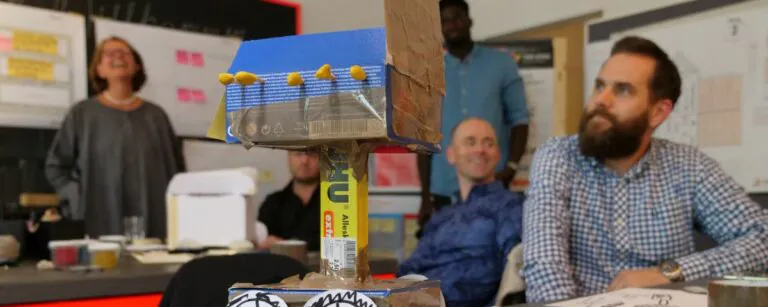A good team creates innovation success. Whether industrial company or start-up. But industrial companies can also learn something from the start-up world. Successful startup investors invest secondarily in good ideas. First and foremost, they invest in good teams. But what actually makes a good innovation team? And how can a company put together a team that is perfectly suited to innovation?
How do you put together a successful innovation team?
The good news. Not only start-ups have successful teams. And successful start-up teams are certainly not transferable one-to-one to established companies. In other words, the answer is of course the same as always:
It depends. It depends.
Of course, that is not enough of an answer. Leaving aside the fact that every team is different and not every team is suitable for everything, there are nevertheless important rules for innovation teams.
1. Voluntariness as the basis for the innovation team
Why is voluntariness crucial for innovation? Because motivation is more important than expertise. The innovation team is not the best 4 developers, who always hang out together and forge wild ideas anyway. Innovation takes place where the familiar is viewed from a new perspective.
How do you find volunteers for the innovation team? Aren’t they all overloaded with day-to-day business anyway?
Many companies have this concern. Without reason. An innovation is a major undertaking. Something really different and new. Properly communicated, it is something that many lick their fingers for. Finally pushing ahead with something exciting and not always doing the same thing. As a rule, you have more interested people than you need. Of course, this requires skillful selection.
Coaching for your innovation project
Do you have a lot of questions? Around the innovation team, approach and conviction of the organization? Innovation coaching provides you with answers. And TOM SPIKE remains in the background as a management consultancy.
2. Team members from different departments, i.e. “cross-functional”
Breaking open silos. Often heard, still relevant. Successful innovations require the involvement of the entire company. After all, the idea not only needs to be conceived, but also successfully produced, packaged, invoiced, distributed and carried through the entire supply chain and value chain into the profit zone.
Can these departments really all contribute to innovation?
The background to the cross-departmental compilation is not the departmental contribution to the pioneering idea. The aim is to safeguard departmental interests and include perspectives. This is the only way to ensure that innovation is ultimately supported by everyone and does not get bogged down by actively or passively blocking areas of the company.
3. Diversity of cultures, professions and genders
No composition is as ineffective for innovation as a same-sex team. This applies to both all-male and all-female groups of people. So this is the easiest dimension to create diversity in the team. And the most important one. The group should also be diverse in the following dimensions:
- Professional and educational background (no pure engineering teams!)
- Cultural backgrounds (nationalities, religions, …)
- Diversity of primary behavior patterns in groups and action preferences (e.g. team roles according to Belbin, rank dynamics according to Schindler, Myers Briggs Type Indicator MBTI, Big Five, etc.)
- Generations and age groups
Doesn’t it all go very slowly when so many different minds are working together? Aren’t communication barriers slowing down progress? Innovation must also be fast.
If you want to go quickly, go alone. If you want to go far, go together
So it’s true. Heterogeneous innovation teams are slower than a group of like-minded, already established team members. In most cases, a compromise would be chosen. Not for the innovation team. The aim here is to create something new. It really pays to make use of time-consuming friction. The fruits are indeed innovative approaches and solutions. And the chance for real innovation. Not just “three percent faster and two percent cheaper”.
4. Compact team size with 4 to 7 team members
Small teams are faster than large ones. Large teams cover more expertise than small ones. What team size for innovation?
If you can’t feed a team with two pizzas, it’s too big (Jeff Bezos)
With a recommended four to seven team members, the perfect innovation team tends to be at the upper end of the Jeff Bezoz scale for meeting and team sizes. And yet the innovation team seems small compared to other groups of people who should and want to drive forward important projects in the company. But that’s good. A team must not only be put together correctly, but must also have the opportunity to grow together as a team and work as a joint team for the most part. This becomes all the more difficult the more people are part of the team. This is because there is usually other day-to-day business to be done in the company. Cohesion quickly crumbles and the votes become endless.
But isn’t that a lack of expertise? Surely a handful of people can’t cover all specialist topics?
Yes, there will be times in the innovation project when additional expertise is needed in the innovation team. The team then brings them in as required. As a stakeholder, extended core team or simply in the form of an expert interview.
Innovation ready for decision in 6 months
Wouldn’t that be a miracle? For some companies and sectors, yes. We can do it anyway. The “innovation marvel” of decision-ready concepts in 6 months. In a tried and tested format.
5. Maximum 6 months for the innovation team
Freedom is a highly prized commodity in innovation. And freedom is important. Limitation is just as important. Limitation in time has proved particularly successful.
Creating real innovation exposes the innovation team to high psychological demands and tensions.
- Are we on the right track?
- What if we fail?
- What will the other departments and managers say?
- Will it really pay off?
- Shouldn’t we finally have something presentable?
These tensions are important. It is precisely there, outside the comfort zone, that innovations emerge. However, the innovation team cannot maintain this tension for more than a maximum of six months. When the first employees go on Christmas vacation, take summer vacations, go on parental leave, managers change, priorities shift, motivation and cohesion crumble.
Is it really possible to create something new and relevant in such a short space of time? Isn’t that far too superficial?
Six months of focus time is quite a lot. In this time, we can do exactly what is necessary. The fixed time frame provides a clear guideline as to how much detail needs to be worked on. What takes too long must be simplified, reduced and further sharpened. Away from over-engineering and towards the really critical questions, assumptions and hurdles. That is what innovation teams are set up for. Not for endless detail work.
Further boundary conditions for the success of innovation teams
- Experienced team leadership and/or moderation
- Sufficient focus time for the team (at least 50% or 20 hours per week)
- No workshop tourism (in a team or outside; no participation according to availability; anyone who has understood Tuckman knows why)
- Freedom in the development of solutions without regular reporting obligations (clear contractor role vis-à-vis the internal client; not a recipient of orders)
Arrange an initial consultation
Management consulting is a matter of trust. Let’s talk briefly about your challenge and find out whether we could work together.
About TOM SPIKE
Successful innovation is created by internal innovation teams. TOM SPIKE is convinced of this. All support is therefore provided with the strong participation of the company’s employees. Innovation teams are the heroes who make innovation possible and turn the company’s innovation strategy into reality. TOM SPIKE is on hand as a guide and provides support where necessary. Where experience is lacking. Where an outside view is needed. Where methodical support helps. Without taking the reins out of the hands of the responsible innovation team.




